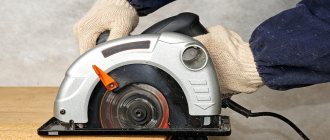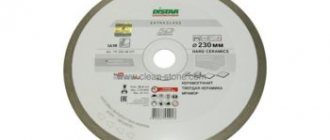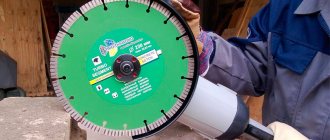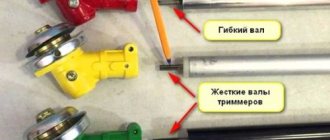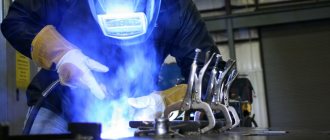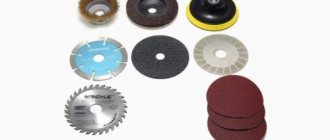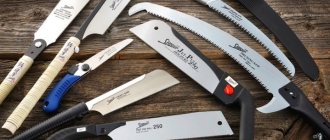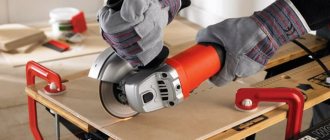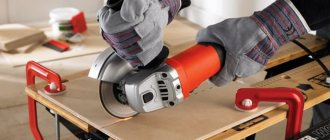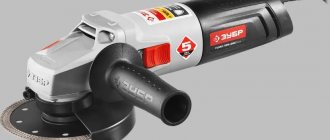Typical disk sizes for angle grinders
All interchangeable wheels have standardized sizes, so for any model of grinder you can choose a suitable size disk, even if it is “non-original” (from another company). The table below shows the typical dimensions of cutting discs in terms of thickness, diameter of the circle and seat:
| Circle diameter, mm | Thickness, mm | Mounting socket, mm |
| 115 | 1,0; 1,6; 2,0; 2,5; 3,0; 3,2 | 22,00; 22,23 |
| 125 | 0,8; 1,0; 1,25; 1,6; 2,0; 2,5; 3,0; 3,2 | 13,20; 22,23 |
| 150 | 0,8; 1,0; 1,25; 1,6; 2,0; 2,5; 3,0; 3,2 | 13,20; 22,23 |
| 180 | 1,0; 1,25; 1,6; 2,0; 2,5; 3,0; 3,2; 4,0 | 22,23; 32,00 |
| 230 | 1,6; 2,0; 2,5; 3,0; 3,2; 4,0 | 22,23; 32,00 |
The larger the diameter of the circle and its thickness, the thicker the products it can cut. Please note that the diameter of the disc should not exceed the permissible size for a particular grinder model. Thus, a 230 mm disc cannot be placed on an angle grinder with a maximum allowable wheel size of 125 mm. Such actions will force you to remove the protection, which is a violation of safety regulations, and will lead to an increase in the linear speed of the cutting edge, which is why the disk can simply fly apart during operation and injure the operator.
The diameter of the seat in most grinders is 22.23 mm, 13.20 mm is less common, and the diameter of 32.00 is relevant only for large disks. Pay attention also to the linear speed of rotation of the disk. For example, if the disc’s marking indicates a speed of 13,000 rpm, this means that your grinder must also produce such revolutions in order to work with it.
You can understand what material the nozzle can work with and what its typical dimensions are by looking at its markings on the front side. If you came to the store and picked up the disc, you can see the following:
We would like to note that sometimes the buyer may encounter non-standard nozzle sizes, and this may apply to both diameter and thickness. This often happens when purchasing “no-name” disks of unknown manufacture. We still recommend buying branded discs, since unknown ones are erased faster, and in the end you have to pay more.
description and properties of the saw blade
Angle grinder (angle grinder), popular among people as a “ grinder”
", is a professional universal device that is used for a variety of purposes. With its help, you can perform a huge amount of work: cutting, grinding, polishing, sawing and processing various raw materials. When choosing a suitable model, you must understand its design features, assess your financial abilities, and also consult with a specialist.
Due to the huge contrast of available models, choosing the perfect solution can be an unmitigated disaster. In any case, the emphasis must be placed on the purpose of the proposed equipment. Wood structures require appropriate grinding wheels for wood grinders. The same goes for metal - it is processed only with suitable tools.
How to correctly change a disc on an angle grinder
Since grinder circles are consumables, at some point they have to be replaced. They are attached to the angle grinder spindle using a pressing flange (nut) with an M14 thread. To unscrew it, the grinder must come with a special open-end wrench that has pins on one side.
So, to change the tool on the grinder, do the following.
- De-energize the device by unplugging the plug from the socket.
- Lock the angle grinder spindle using the button located on the front of the body. When the button is pressed, the stopper enters the hole of the disk installed in the gearbox, which fixes the spindle in a stationary position.
- Insert the key pins into the holes on the clamping flange.
- While holding the latch with one hand, turn the key to the left (counterclockwise) with the other hand until the nut comes off. Then you can unscrew it without a key and remove it from the shaft. In this case, the spindle of the angle grinder rotates clockwise. But in which direction should you unscrew the nut if your device’s shaft rotates counterclockwise? Remember: the clamping flange should always be unscrewed in the direction opposite to the rotation of the shaft.
- Now you can change the tool, having previously removed the old one. If you see that dirt has accumulated inside the casing, then you should remove the lower flange and use a metal brush to remove dirt from all surfaces.
- Screw the flange onto the shaft by hand. Tighten the nut until you can no longer turn it without a wrench. Then, holding the stopper, tighten this nut using a wrench, but less than a quarter turn, otherwise the disk will begin to deform.
- “ Bulgarian
” is a high-speed machine. And although the metal from which the cutting discs are made is strong, it cannot withstand this mode for a long time. More precisely, cutting edges (teeth), which are fixed by soldering. During intensive work, they fall off and fly apart, at high speed. The consequences are not difficult to predict. - Not all discs are suitable in size (first, outer diameter) for installation on an angle grinder. This means you will have to remove the protective casing. The same thing - you can forget about employee safety.
- The structure of wood (even hard wood) is quite loose. As follows, there is a high possibility that the saw blade may jam due to constant vibration. No one can predict how the “grinder” will behave in a similar situation, taking into account its power and speed. But the fact that it will easily escape from your hands is absolutely certain.
- Unchanged mode configurations (for the same reason - the viscosity of lumber) lead to periodic overheating of the angle grinder motor. With this use, the “ grinder ” will not serve for a long time.
After carrying out the above actions, the replacement of the tool is considered completed.
On a note!
Wood processing also involves its cutting (sawing). From time to time, when manufacturing piece parts, you have to adjust them to the installation site even before you start grinding the standard. Some “craftsmen” (and there are many of them among friends and on the Internet) recommend using circular saw blades for such operations. Strictly prohibited! Here are just the main reasons why this cannot be done.
Unwinding methods if the disk is jammed
What to do if the clamping flange is jammed? This problem, when the nut is bitten, often occurs if, while working with thick and strong materials, the tool jams in the workpiece. With all this, the abrasive wheel often breaks, and the spindle that continues to rotate tightly tightens the pressing flange. To unscrew the grinder if the disk is jammed, there are several methods.
READ Discs for cutting metal angle grinders
Purpose of discs and attachments
Grinder circles differ in purpose for:
- cutting;
- roughing
- grinding;
- sharpening
Using Penetrating Lubricant
Liberally spray the flange/shaft joint with WD-40. It tends to seep into inter-threaded spaces and small cracks. After applying water, wait about 5 minutes and try to unscrew the fastener with a standard wrench.
Pros and cons of different attachments
The abrasive wheel has an affordable price, there is always a wide range and some versatility. But it wears out quickly, which is accompanied by the emission of sparks during implementation, which can lead to a fire.
During the implementation process, a nasty odor arises that does not dissipate for a long time. This makes the tool difficult to use indoors.
Discs with diamond chips do not cause sparks, and there is virtually no strong aroma. But such a circle is afraid of overheating, so it is necessary to take breaks during the implementation process. If a non-segmented circle is used, then liquid cooling is necessary. And its cost is also quite high.
Cutting discs
Cutting discs are most often used when working with an angle grinder. The following nozzles are distinguished by purpose:
- For metal. Such cutting wheels are made from electrocorundum or crystalline corundum. In this case, a bakelite bond is often used inside the product. Depending on the thickness and size, the disc can cut metal profiles, stainless steel, heating pipes, etc. GRAFF GADM 115 10 is one of the representatives of inexpensive metal discs.
- For stone and concrete. Circles for cutting stone and concrete are made of silicon carbide. Please note that the disc is intended for relatively “soft” materials, such as white brick and slate (harder ones will require a diamond wheel).
- For ceramic tiles and concrete. This attachment is designed for cutting paving stones, ceramic tiles, red bricks, cutting strips for gating, etc. The disc itself is made of metal with diamond chips applied to the cutting edge. There are solid all-metal and segmented discs. The first ones are intended for wet cutting (cooling with water), as they become very hot during the process. Segmented ones are convenient for dry cutting, and they are the most popular among diamond blades. Here, for example, is a high-quality, durable segmented disk Makita B-28086 for cutting concrete and stone products.
- For wood . Discs for processing wooden structures are made of tungsten carbide or metal with abrasive coating. The first ones are designed for cutting hard and soft wood, plasterboard, gas silicate and MDF. The second one can also cut metal and even wood with nails (but this needs to be checked experimentally). Bison Professional 36859-125 is just such a representative of the “nail saw”.
- Universal. These attachments can cut almost all types of materials (for wood, it is better to take a direct-use attachment). In particular, they are convenient to use when you have to cut different materials in one working day, and you don’t want to waste time changing the nozzle. Universal models even cut reinforced concrete. However, they are often quite expensive, and sometimes it is more profitable to buy two disks for different types of materials being processed. Of the good universal circles, we can recommend Wolverine 100125, which is suitable for both wet and dry cutting.
Ensuring safe operation
Each electronic tool is supplied with an instruction on non-hazardous operation. But you should keep in mind the main rules:
- it is necessary to change the circle only after the tool is de-energized;
- you need to use a protective casing when cutting metal;
- you should definitely wear special glasses and gloves;
- You cannot use a cutting wheel for grinding, and a grinding wheel for cutting;
- The device cannot be used near flammable materials due to the risk of sparks.
It must be understood that when cutting, the disk must spin so that sparks fly at the master, so the grinder will not be able to bounce off at his head if the disk jams.
Correct cutting of metal for economical consumption of abrasive. The abrasive will be consumed more slowly if you cut metal according to the following rules:
- long workpieces must be cut at the edge; if work is carried out between the support points, the circle will jam when the cut is compressed;
- cutting can only begin when the disk reaches high speeds;
- Pressure adjustment should be carried out according to the feeling of the load on the nozzle. When the speed decreases, it is necessary to weaken the force; when it increases, the force must also become greater;
- it is necessary to enter the metal smoothly;
- if the material is not simple, then you can make reciprocating movements at the point where the nozzle touches the metal;
- The corner should be cut in 2 steps, each side in turn. The profile should also be cut;
- pauses in work are necessary (5-10 minutes).
READ Is it possible to cut tiles with a grinder
You should definitely use water to pour it over the cut area, but you need to make sure that moisture does not get into the body of the electronic instrument.
Roughing
It’s worth mentioning right away that roughing and grinding discs go hand in hand, and in many stores in the “type” parameter of the attachment it may be written: “roughing grinding disc.” In our article we will divide this “couple” into two types. Peelers in this context are an attachment for freeing the structure being processed from the outer layer, for example, from rust. There are the following peeling attachments:
- Cord brushes. Cord brushes are disc or cup-shaped. Disc ones are convenient for cleaning vertical structures, for example, a tubular fence, and cup-shaped ones are used for cleaning horizontal surfaces. So cord brushes are very convenient for cleaning a car body after welding or removing rust. Here is an average-priced brass cord brush STAYER 35125-150:
- Roughing discs. Sanding discs, like cord brushes, can be flat or cup-shaped. They are intended for cleaning welds and preparing metal surfaces for grinding.
Grinding
Grinding wheels are used for polishing concrete, metal and wooden surfaces for painting or priming. Attachments for circles can be made of sandpaper, felt and even felt. In turn, the design of sanding wheels can be petal or flat (put on a wheel).
Each grinding disc has its own grit size. It is selected depending on the work being performed. Below is a table for selecting wheel grit depending on the type of grinding:
| Types of grinding | Recommended grit number |
| Flat | 16 — 36 |
| Round roughing | 24 — 36 |
| Round finishing | 60 — 100 |
| Finishing a multi-blade tool | 170 — 220 |
| Finishing | 180 — 320 |
| Thread grinding | 100 — 280 |
To summarize: how to choose a disc for an angle grinder?
To properly buy a disc for an angle grinder, you need to:
- Know the maximum size of disks that your angle grinder can handle. You cannot take disks larger than the device allows.
- Know the maximum speed of the grinder . The higher the rotation speed of the angle grinder, the smaller the disk size it can work with.
- Processed material . There are discs for wood, metal and stone. There are universal ones that can cut almost anything.
- Socket size . The size of the wheel seat must correspond to the same parameter in the angle grinder.
- Manufacturer . Do not buy frankly cheap discs or unknown products like hot cakes in the school cafeteria, and the savings will be minimal.
How to replace
The grinder disc is a consumable item. Therefore, it has to be changed frequently. There is a simple algorithm in which an important role is played by the original design of the key supplied to the consumer along with the grinder.
- — The protruding rods of a special key are installed in the grooves of the fastening nut.
- — At the same time, press the lock button located on the gearbox housing. It will lock the rotor from turning.
- — Turn the key counterclockwise to release the fasteners of the worn disk.
- — The old disk is replaced with a new one of the same technical characteristics and size. The new disk is installed with the markings facing out to remind you of the disk parameters and for other good reasons (see explanation in the video above).
- — The fastening nut is first tightened by hand and finally tightened with a special wrench.
The Bulgarian is ready to continue fulfilling its functional purpose.
